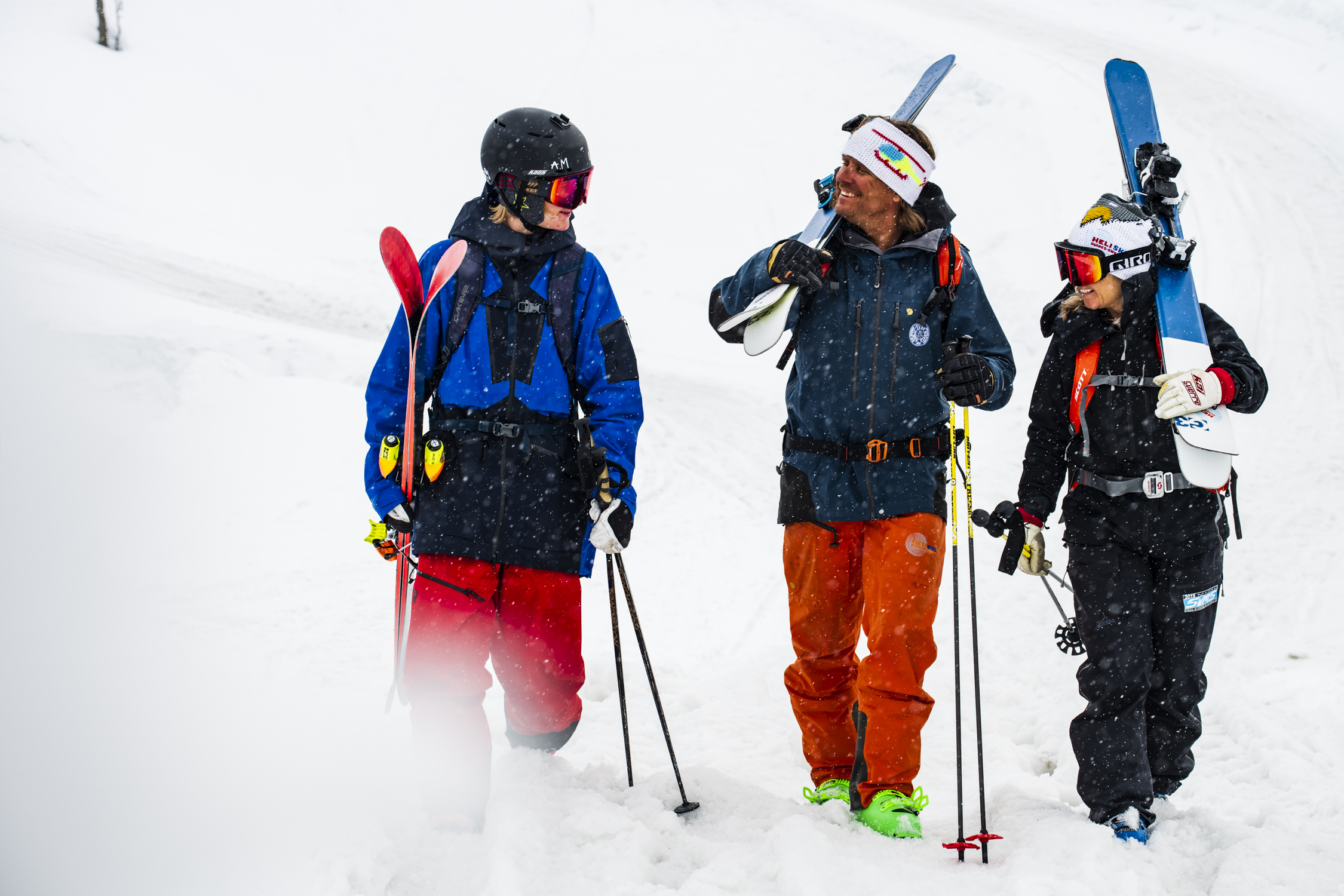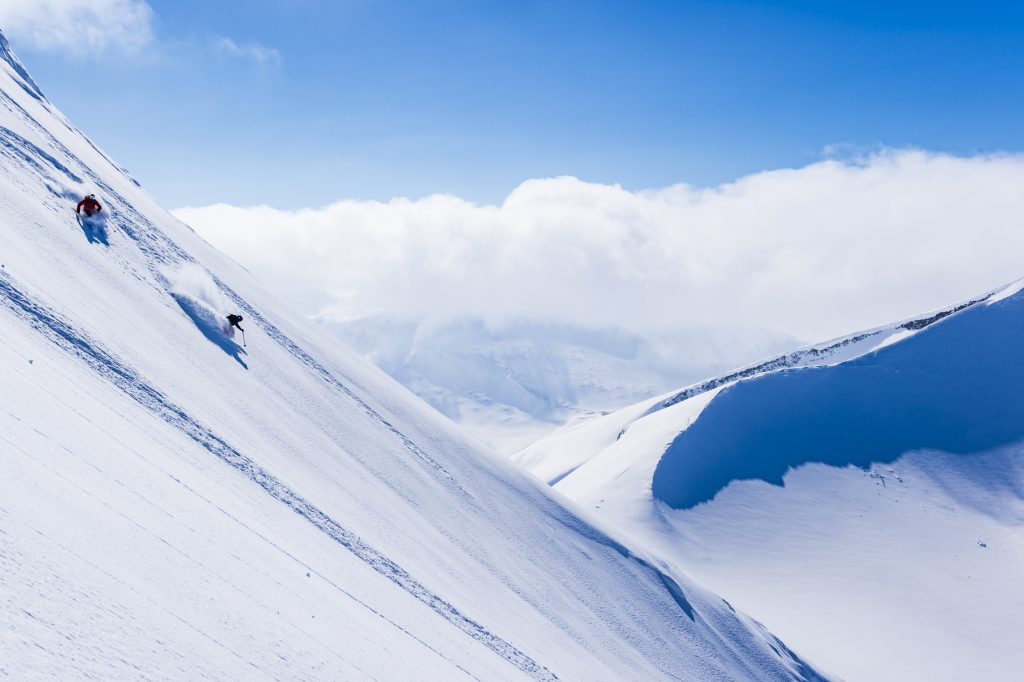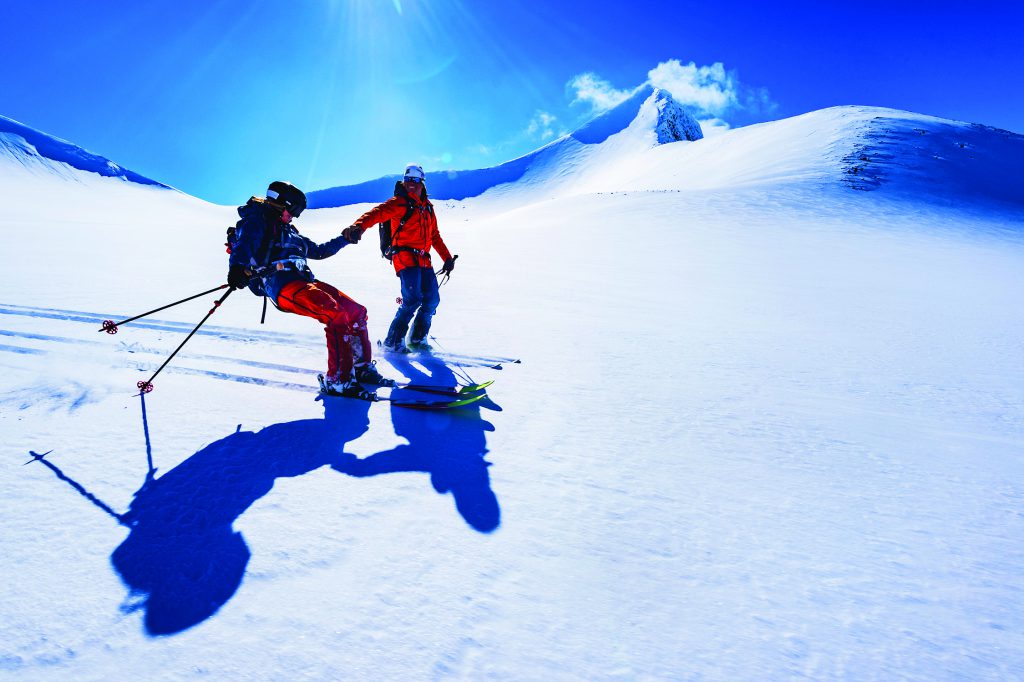In Search of Powder in Arctic Lapland with freeride royalty


Minutes earlier we’d sat in sun outside Abisko Mountain Lodge catching rays in reindeer-skin-draped chairs, so the plateau’s sudden wintery breeze is sharp enough to chase us quickly down the ridge. The run is wind-affected with a definite crunch beneath, so we traverse onto a 2500-vertical-foot northeast face that promises better. Though it’s a perfect heli-ski run – steep, consistent, uninterrupted – the snow improves only marginally, so I take my time. Conditions be damned, however, two skiers fly past me, egging each other on, arcing huge GS turns through changeable snow at a speed I could never contemplate. Strong and competent, they disappear over a convexity, reappearing minutes later as valley-bottom ants.
One of those skiers is Max Palm, a 16-year-old tearing up the World Junior Freeride circuit. He’d spent most of the day up the road at Riksgränsen qualifying for the resort’s annual Scandinavian Big Mountain Championships. The other is Max’s mother Pia, a three-time champion of that same event, one she helped ignite in the heady freeride days of the early 1990s. They’re more than just mother and son connected by an arcane Arctic freeride heritage, though. With paterfamilias Stefan often away on global guiding missions, they’re also longtime ski buddies, and watching their pas de deux would warm the heart of any soul skier.
“I’m nervous on days like this,” Pia had confessed earlier. Awaiting news of Max’s run and aware of icy conditions on the venue, she’d kept her phone close, flinching whenever it lit up. Now that he’s returned safely and they’re skiing together, she hugs him often, tilting her head to touch his, glad that he survived and did well, something the demure teen is loath to admit.
“I have no idea how I placed, but I was happy with my run,” Max shrugs. With skiing both a passion and a family business, he’s long-since learned that there’s no point dwelling on an unchangeable past when you’re having fun in the present. At the next drop-off, Max points to a ridge half-a-kilometre away where a narrow cornice edges a shallow natural halfpipe. “I can backflip off that,” he tells photographer Mattias Fredriksson, a family friend who’s been shooting him and older sister Robina – also a formidable skier – since they were young. Pia pays no heed to this news; it’s business as usual.
With Mattias set up, Max tracks across the face, drops into the tube and exits in a full inverted layout, landing on the relative flats beyond. Only half joking, I ask Pia how watching something like that is for a mother. “I’m OK with it,” she answers flatly. “I’ve seen worse.”
Flying back to the lodge is a study in the fulsome emptiness of the Arctic – like watching a widescreen IMAX film with no edges. Barely discernible among the Pollack-like swaths of dwarf birch, the hamlet of Abisko faces a broad sweep of mountain on the far side of Torneträsk, a massive glacial lake. With only 150 residents and a one-room school, it’s still the biggest village along the lonely road stitching Sweden’s far north to Norway. If you blink, you miss it. I know because I did just that driving there on the lone road, and had to backtrack several kilometres.
Sweeping into the lodge, we’re soon chasing slow-cooked moose with an excellent Bourgogne Pinot Noir. At a longer table, a boisterous group of 15 are celebrating their 14th trip here and what one describes as “the best day of heliskiing we’ve ever had here.”
Contrasting the Nordic chic of the airy dining room is a comfortable central lounge of soft sofas, plush chairs, and typical ski-lodge kitsch – books, photography, art, old skis, mounted antlers. A fridge behind the all-purpose front desk brims with microbrews and wine.
Dick Johansson and wife Mina, who run Abisko Mountain Lodge, have known Stefan and Pia for decades, and four years ago had them take over the lodge’s ski touring and heli-ski franchise. The lodge is booked out for northern lights tourism until the heli-ski season begins in late March, running through mid-May – the period locally known as Vårvinter (Spring-Winter). Though Stefan brings a raft of longtime clients to this vernal powfest, more and more first-time clients are being drawn by word of exceptional skiing and the lodge’s relaxed, homey feel.

Overnight, blue skies are replaced by a howling storm. Despite the weather, organisers in Riksgränsen do everything they can to ensure competitors get a run in – with more bad weather pending it may be the only chance they get. Trying desperately to ignore her phone, Pia hears through friends that Max finished his run, throwing a huge 360 and a backflip, landing both and skiing strongly. “I am super happy” he texts. Pia glows with pride, and possibly relief. When she receives a TV clip of his run, Mattias and I crowd around her phone to watch. As Max uncorks his 360 the crowd ooohs; when he backflips they go nuts. It stands as the day’s top run.
Later, we find out that adding today’s score to his qualifier has put Max in first place overall against the cream of Scandinavian freeskiing. Given tomorrow’s forecast of snow there’s a good chance additional runs will be cancelled and Max will be crowned champ. Pia is ebullient at the prospect, and with Stefan flying in from Iceland tonight, the three would be able to celebrate together – the only lamentable absence being Robina, who usually makes the spring pilgrimage with the family but is currently studying communication science at the University of Amsterdam.
Moreover, if Max wins, it will be the closing of an unprecedented circle for Pia and Stefan.
Pia grew up outside Stockholm, with a history of ski and mountain exploits on both sides of the family. Her own alpine path started with racing for a local ski club. There were frequent holidays to the mountains, and an annual trip to Austria in a car stacked with three kids.
Spring pilgrimages to Lapland began in the early 1980s before there was a road, when Pia would take the train north with friends. She soon started instructing at Riksgränsen, and in 1990 met fellow instructor Stefan Palm. They put in a few Arctic springs together, heading to New Zealand to ski when summer hit.
Stefan’s backstory is a fitting arc for the country’s most famous guide. Originally from Sweden’s flat southland, he got into mountains, skiing and travelling with friends in the 1980s, returning home only long enough to make money for a next adventure. Worried he might be wasting his life, his mother met him on the doorstep after yet another trip. “I’ve enrolled you in an outdoor leadership school,” she told Stefan, holding out a pile of papers on which she’d forged his signature. He decided to give it a try. Two years later he graduated, taking on jobs like rigging and safety for a live TV event in Riksgränsen, and enrolling in a course that would see him become one of Sweden’s first certified mountain guides.
Having also shared a dream of running a ski lodge, and when buddy Pelle Lång called to say he’d purchased a small lodge hotel in a lonely French outpost called La Grave known for off-piste skiing and that he needed staff and guides, Pia and Stefan jumped. They moved to La Grave in 1994 to run La Chaumine – a name that, over the decade they spent there, became synonymous with the infamously rule-free mountain freeski paradise.
The Palms eventually moved to the larger ski town of Serre Chevalier to purchase a house and raise a family. Their first-born, Robina – aka ‘Robi’ – raced with the local ski club for a few years, a good technical foundation for the freeskiing she and Max would eventually adopt. As the kids grew, need arose for more schools, more culture, and a more convenient airport. After 10 years in Serre Chevalier the family uprooted to the village of Servoz, an hour from Geneva just below Chamonix. From here, Stefan guides around the globe: Japan, India, Iceland, Norway, and the Chilean Andes, where he’s known as Sabuezo de Sueco – ‘the Swedish bloodhound’ – for his unerring knack of always finding the best snow. But the most important trip he makes each year is back to Swedish Lapland, where it all started.
It was Stefan and Pia, in fact, who’d introduced heli-skiing to northern Sweden, initially operating through the Riksgränsen ski school. They eventually started their own company, Heliski Guides Sweden, with Stefan as lead guide, Pia as coordinator, and Robina lending expertise to social media and other marketing efforts.
In 2015 they moved their base from Riksgränsen to Dick’s Abisko Mountain Lodge. With its jaw-drop scenery of swooping Arctic tundra, enormous lakes, jagged mountainscape, runs of 500–1,400 vertical metres, plus two helicopters at the door, it’s one of the most exclusive and unique such operations in the world, benefitting in no small measure from guiding by the area’s de facto pioneer. “Stefan has an amazing ability to see lines and find the best snow,” says Dick. “His routes and knowledge of these mountains are totally unique.”
After skiing with Sabuezo de Sueco, it’s hard to deny his snow-sniffing skill. But it’s also hard to deny the family’s long-time connection to this sweeping land, to who they are, what they do, their love for its fragile qualities. “You have to feel something from this light,” Stefan once told me after we’d scrambled to the top of a peak near Riksgränsen around 8pm, only to be washed, as we descended, in the kind of copper only the midnight sun can deliver.

As expected, further competition is cancelled the next day and Max is declared winner of the 2019 Scandinavian Big Mountain Championships. Mattias and I join Stefan and Pia as they drive the hour to Riksgränsen to congratulate him. Pia literally shakes with excitement en route, aided by a double cappuccino downed before we left.
When we arrive, it’s to the sight of Max being interviewed on TV. Once the interview concludes, however, he’s fair game for hugs and backslaps – including from the event’s venerable founder, Robert Gustafsson, with whom Pia worked to get it off the ground 27 years earlier. Not only is Max the youngest winner ever, remarks Robert, but the first with a parent who has also won, a generational watershed.
My last day with the family Palm is golden. With new snowfall blanketing the peaks and the skies clearing, we fly off to explore one of Stefan’s ‘secret’ stashes – something that it’s no small feat to conceal in an area where several heli-ski operations share the same tenure of around 60 peaks. Stefan leads us to faces and gullies filled with powder where we ski line after untracked line on a variety of exposures. Max even throws a massive, celebratory backflip off a cornice into a steep bowl, almost wiping out before pulling it together at the last second as only a rubber-bodied teen can.
We lunch in the sun on rolled-out seating pads, sharing a massive thermos of thick, potato-leek soup from the lodge, followed by coffee and homemade cannelbulla, a traditional Swedish cinnamon bun. Mattias needs a dramatic background for some final photos, and Stefan suggests a different zone, where the snow proves to be three times as deep as anything we’ve skied, rippling across steep, shadowed slopes in unconsolidated waves. It’s not just the best powder of the trip, but the best I’ve ever skied in a dozen trips to Sweden.
“I haven’t skied snow like this for a long time,” I say.
“That’s because you haven’t skied with me for a long time,” quips Stefan.
Though they’ve probably heard it before, both Pia and Max can’t help laughing out loud.
Abisko Mountain Lodge (abiskomountainlodge.se) offers a range of tailor-made packages. For example, a four-day package, including full-board lodge accommodation and one hour of heli-skiing a day per group, costs from 50,800SEK (£4100) per person.
The nearest airport is Kiruna (90 minutes away); SAS and Norwegian operate flights to Kiruna from London. Visit sas.se or norwegian.com.